KIA Cerato 2014 2.G Owner's Manual
Manufacturer: KIA, Model Year: 2014, Model line: Cerato, Model: KIA Cerato 2014 2.GPages: 446, PDF Size: 7.32 MB
Page 431 of 446
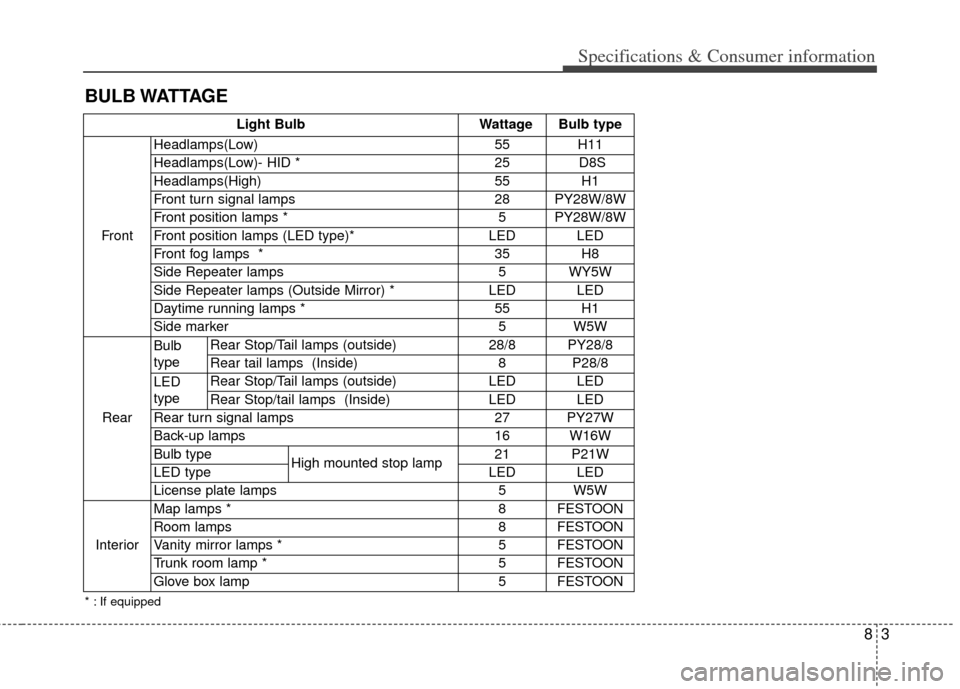
83
Specifications & Consumer information
BULB WATTAGE
Light BulbWattage Bulb type
Front Headlamps(Low)
55 H11
Headlamps(Low)- HID * 25 D8S
Headlamps(High) 55H1
Front turn signal lamps 28 PY28W/8W
Front position lamps * 5 PY28W/8W
Front position lamps (LED type)* LED LED
Front fog lamps * 35H8
Side Repeater lamps 5 WY5W
Side Repeater lamps (Outside Mirror) * LED LED
Daytime running lamps * 55H1
Side marker5W5W
Rear Bulb
type
Rear Stop/Tail lamps (outside) 28/8 PY28/8
Rear tail lamps (Inside) 8 P28/8
LED
type Rear Stop/Tail lamps (outside) LED LED
Rear Stop/tail lamps (Inside) LED LED
Rear turn signal lamps 27 PY27W
Back-up lamps 16 W16W
Bulb type High mounted stop lamp 21 P21W
LED type LED LED
License plate lamps 5 W5W
Interior Map lamps * 8 FESTOON
Room lamps 8 FESTOON
Vanity mirror lamps * 5 FESTOON
Trunk room lamp * 5 FESTOON
Glove box lamp 5 FESTOON
* : If equipped
Page 432 of 446
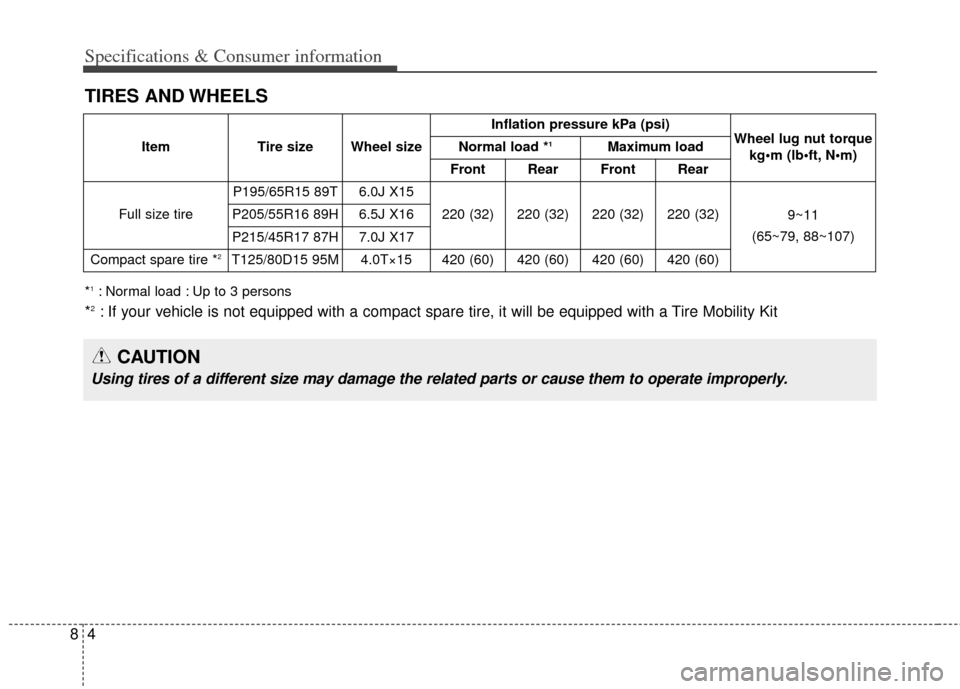
Specifications & Consumer information
48
TIRES AND WHEELS
CAUTION
Using tires of a different size may damage the related parts or cause them to operate improp\
erly.
*1: Normal load : Up to 3 persons
*2: If your vehicle is not equipped with a compact spare tire, it will be equipped with a Tire Mobility Kit
ItemTire size Wheel size Inflation pressure kPa (psi)
Wheel lug nut torque
kg•m (lb N
Normal load *1Maximum load
Front Rear Front Rear
Full size tire P195/65R15 89T 6.0J X15
220 (32) 220 (32) 220 (32) 220 (32) 9~11
(65~79, 88~107)
P205/55R16 89H 6.5J X16
P215/45R17 87H 7.0J X17
Compact spare tire *
2T125/80D15 95M 4.0T×15 420 (60) 420 (60) 420 (60) 420 (60)
Page 433 of 446
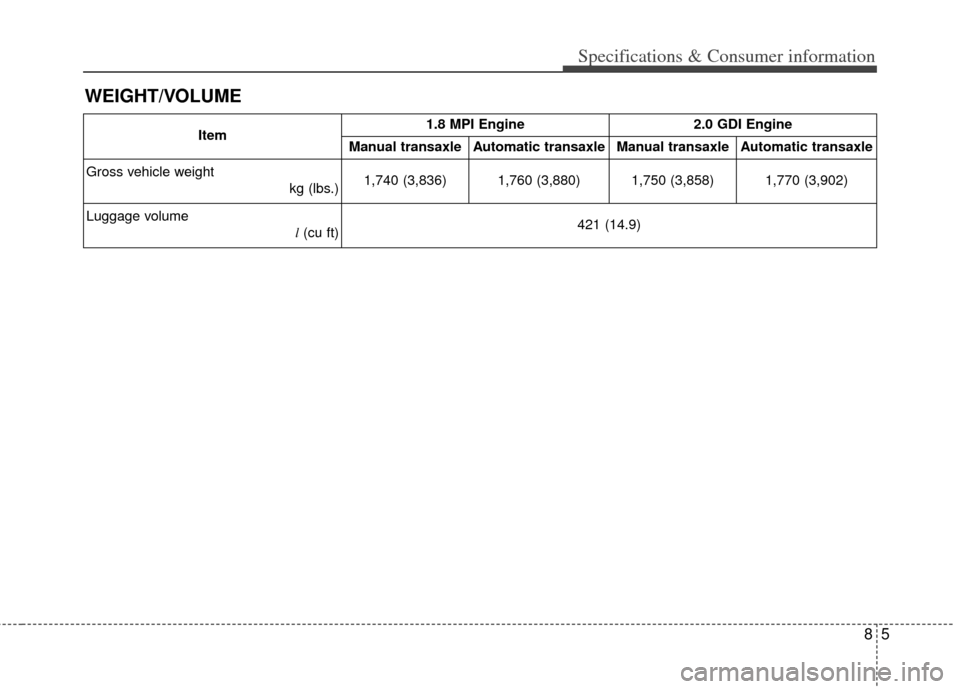
85
Specifications & Consumer information
WEIGHT/VOLUME
Item1.8 MPI Engine2.0 GDI Engine
Manual transaxle
Automatic transaxleManual transaxle Automatic transaxle
Gross vehicle weight kg (lbs.)1,740 (3,836)
1,760 (3,880)1,750 (3,858) 1,770 (3,902)
Luggage volume l(cu ft)
421 (14.9)
Page 434 of 446
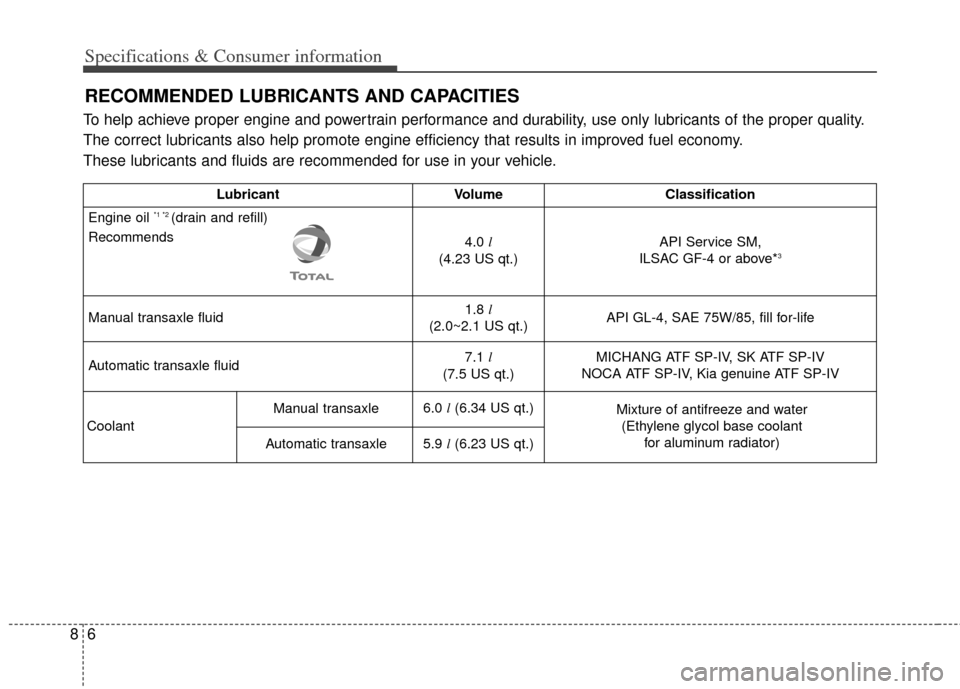
Specifications & Consumer information
68
RECOMMENDED LUBRICANTS AND CAPACITIES
To help achieve proper engine and powertrain performance and durability, use only lubricants of the proper quality.
The correct lubricants also help promote engine efficiency that results in improved fuel economy.
These lubricants and fluids are recommended for use in your vehicle.
LubricantVolumeClassification
Engine oil *1 *2 (drain and refill)
Recommends
4.0 l
(4.23 US qt.)API Service SM,
ILSAC GF-4 or above*3
Manual transaxle fluid1.8 l
(2.0~2.1 US qt.)API GL-4, SAE 75W/85, fill for-life
Automatic transaxle fluid7.1 l
(7.5 US qt.)MICHANG ATF SP-IV, SK ATF SP-IV
NOCA ATF SP-IV, Kia genuine ATF SP-IV
Coolant
Manual transaxle6.0 l(6.34 US qt.)Mixture of antifreeze and water
(Ethylene glycol base coolant for aluminum radiator)
Automatic transaxle5.9 l(6.23 US qt.)
Page 435 of 446
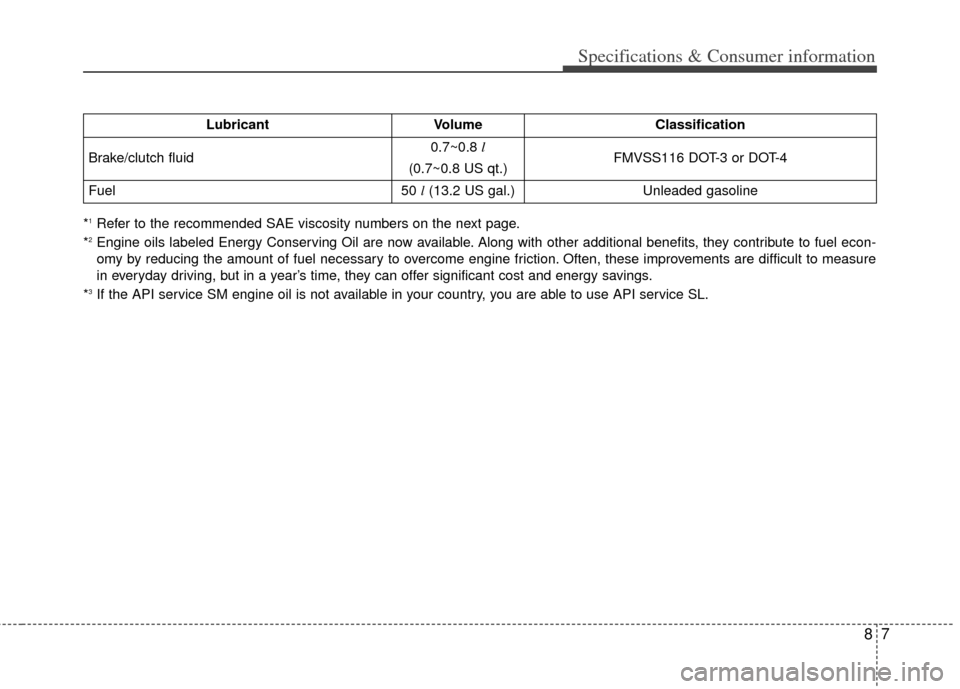
87
Specifications & Consumer information
*1Refer to the recommended SAE viscosity numbers on the next page.
*2Engine oils labeled Energy Conserving Oil are now available. Along with other additional benefits, they contribute to fuel econ-
omy by reducing the amount of fuel necessary to overcome engine friction. Often, these improvements are difficult to measure
in everyday driving, but in a year’s time, they can offer significant cost and energy savings.
*
3If the API service SM engine oil is not available in your country, you are able to use API service SL.
LubricantVolumeClassification
Brake/clutch fluid0.7~0.8 l
(0.7~0.8 US qt.)FMVSS116 DOT-3 or DOT-4
Fuel50 l(13.2 US gal.)Unleaded gasoline
Page 436 of 446
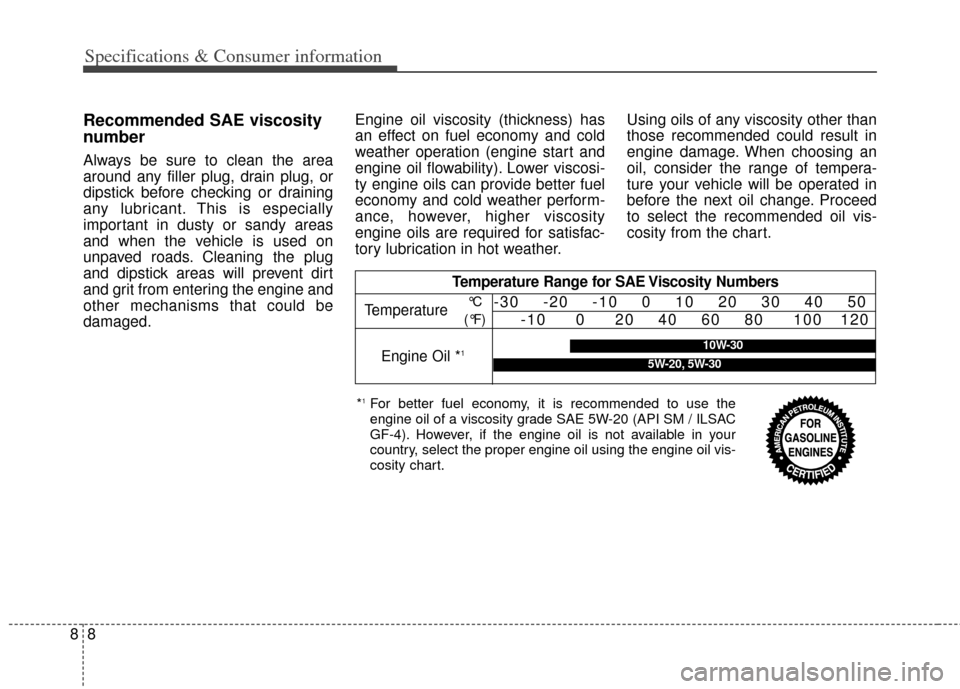
Specifications & Consumer information
88
Recommended SAE viscosity
number
Always be sure to clean the area
around any filler plug, drain plug, or
dipstick before checking or draining
any lubricant. This is especially
important in dusty or sandy areas
and when the vehicle is used on
unpaved roads. Cleaning the plug
and dipstick areas will prevent dirt
and grit from entering the engine and
other mechanisms that could be
damaged.Engine oil viscosity (thickness) has
an effect on fuel economy and cold
weather operation (engine start and
engine oil flowability). Lower viscosi-
ty engine oils can provide better fuel
economy and cold weather perform-
ance, however, higher viscosity
engine oils are required for satisfac-
tory lubrication in hot weather.
Using oils of any viscosity other than
those recommended could result in
engine damage. When choosing an
oil, consider the range of tempera-
ture your vehicle will be operated in
before the next oil change. Proceed
to select the recommended oil vis-
cosity from the chart.
Temperature Range for SAE Viscosity Numbers
Temperature
Engine Oil *
1
°C
(°F)-30 -20 -10 0 10 20 30 40 50 -10 0 20 40 60 80 100 120
10W-30
5W-20, 5W-30
*1For better fuel economy, it is recommended to use the
engine oil of a viscosity grade SAE 5W-20 (API SM / ILSAC
GF-4). However, if the engine oil is not available in your
country, select the proper engine oil using the engine oil vis-
cosity chart.
Page 437 of 446
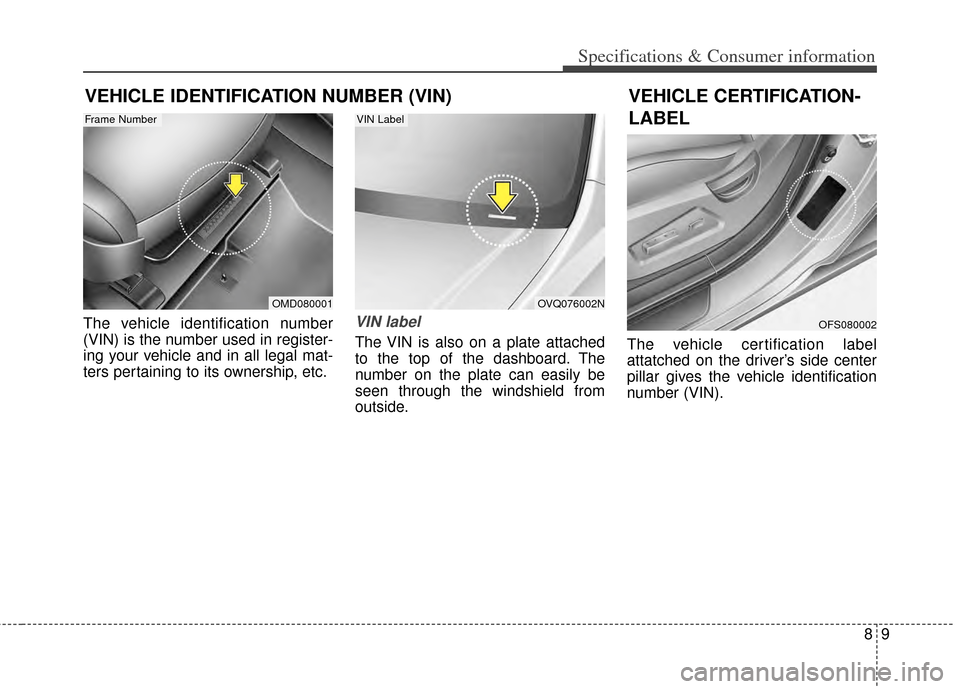
89
Specifications & Consumer information
VEHICLE IDENTIFICATION NUMBER (VIN)
The vehicle identification number
(VIN) is the number used in register-
ing your vehicle and in all legal mat-
ters pertaining to its ownership, etc.VIN label
The VIN is also on a plate attached
to the top of the dashboard. The
number on the plate can easily be
seen through the windshield from
outside.The vehicle certification label
attatched on the driver’s side center
pillar gives the vehicle identification
number (VIN).
OVQ076002N
VIN Label
OMD080001
OFS080002
VEHICLE CERTIFICATION-
LABEL
Frame Number
Page 438 of 446
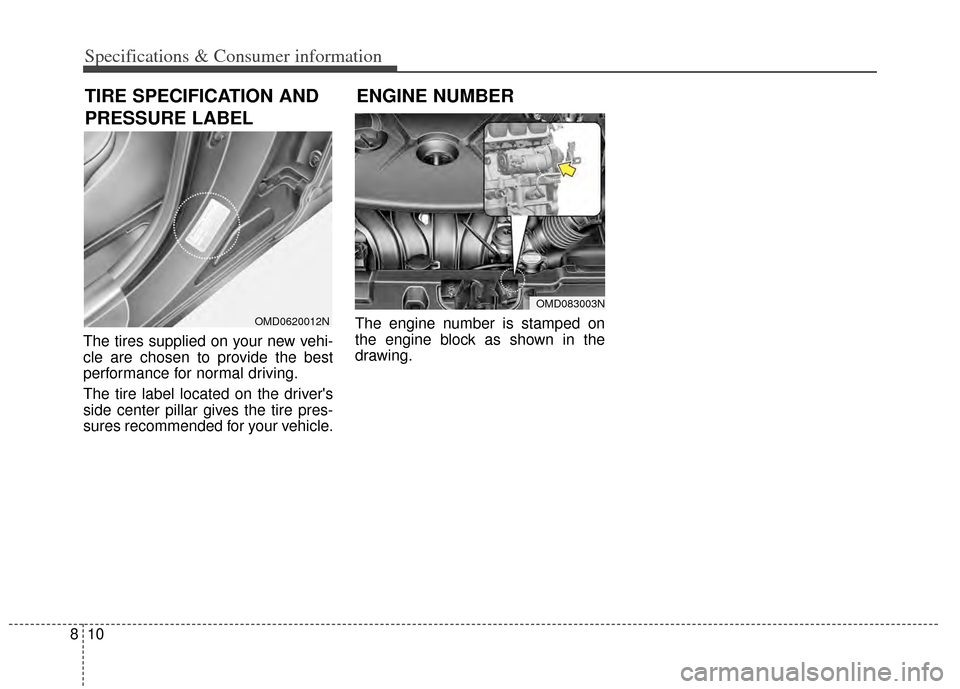
Specifications & Consumer information
10
8
The tires supplied on your new vehi-
cle are chosen to provide the best
performance for normal driving.
The tire label located on the driver's
side center pillar gives the tire pres-
sures recommended for your vehicle. The engine number is stamped on
the engine block as shown in the
drawing.
TIRE SPECIFICATION AND
PRESSURE LABEL
OMD0620012N
ENGINE NUMBER
OMD083003N
Page 439 of 446
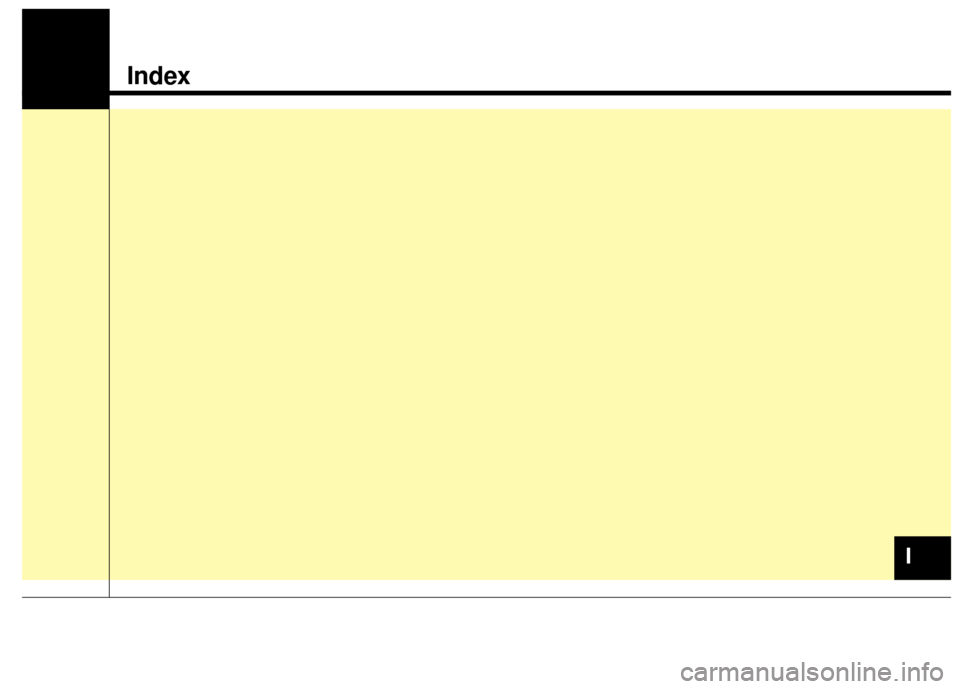
Index
II
Page 440 of 446
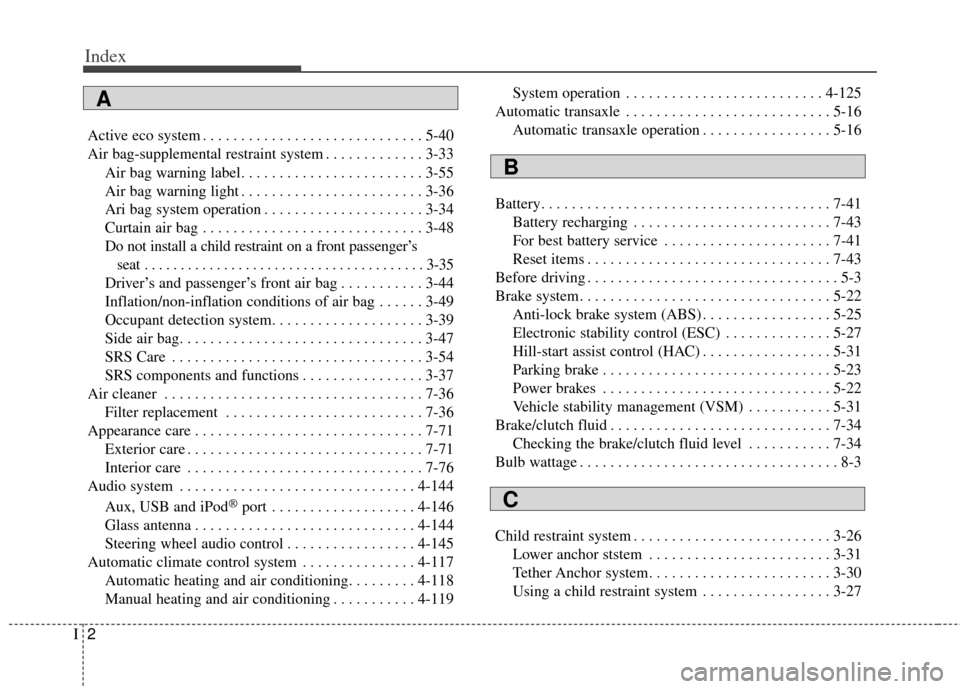
Index
2I
Active eco system . . . . . . . . . . . . . . . . . . . . . . . . . . . . . 5-40
Air bag-supplemental restraint system . . . . . . . . . . . . . 3-33Air bag warning label. . . . . . . . . . . . . . . . . . . . . . . . 3-55
Air bag warning light . . . . . . . . . . . . . . . . . . . . . . . . 3-36
Ari bag system operation . . . . . . . . . . . . . . . . . . . . . 3-34
Curtain air bag . . . . . . . . . . . . . . . . . . . . . . . . . . . . . 3-48
Do not install a child restraint on a front passenger’sseat . . . . . . . . . . . . . . . . . . . . . . . . . . . . . . . . . . . . \
. . . 3-35
Driver’s and passenger’s front air bag . . . . . . . . . . . 3-44
Inflation/non-inflation conditions of air bag . . . . . . 3-49
Occupant detection system. . . . . . . . . . . . . . . . . . . . 3-39
Side air bag. . . . . . . . . . . . . . . . . . . . . . . . . . . . . . . . 3-47
SRS Care . . . . . . . . . . . . . . . . . . . . . . . . . . . . . . . . . 3-54
SRS components and functions . . . . . . . . . . . . . . . . 3-37
Air cleaner . . . . . . . . . . . . . . . . . . . . . . . . . . . . . . . . . . 7-36\
Filter replacement . . . . . . . . . . . . . . . . . . . . . . . . . . 7-36
Appearance care . . . . . . . . . . . . . . . . . . . . . . . . . . . . . . 7-71 Exterior care . . . . . . . . . . . . . . . . . . . . . . . . . . . . . . . 7-71
Interior care . . . . . . . . . . . . . . . . . . . . . . . . . . . . . . . 7-76
Audio system . . . . . . . . . . . . . . . . . . . . . . . . . . . . . . . 4-144
Aux, USB and iPod
®port . . . . . . . . . . . . . . . . . . . 4-146
Glass antenna . . . . . . . . . . . . . . . . . . . . . . . . . . . . . 4-144
Steering wheel audio control . . . . . . . . . . . . . . . . . 4-145
Automatic climate control system . . . . . . . . . . . . . . . 4-117 Automatic heating and air conditioning. . . . . . . . . 4-118
Manual heating and air conditioning . . . . . . . . . . . 4-119 System operation . . . . . . . . . . . . . . . . . . . . . . . . . . 4-125
Automatic transaxle . . . . . . . . . . . . . . . . . . . . . . . . . . . 5-16 Automatic transaxle operation . . . . . . . . . . . . . . . . . 5-16
Battery. . . . . . . . . . . . . . . . . . . . . . . . . . . . . . . . . . . . \
. . 7-41 Battery recharging . . . . . . . . . . . . . . . . . . . . . . . . . . 7-43
For best battery service . . . . . . . . . . . . . . . . . . . . . . 7-41
Reset items . . . . . . . . . . . . . . . . . . . . . . . . . . . . . . . . 7-43
Before driving . . . . . . . . . . . . . . . . . . . . . . . . . . . . . . . . . 5-3
Brake system. . . . . . . . . . . . . . . . . . . . . . . . . . . . . . . . . 5-22 Anti-lock brake system (ABS) . . . . . . . . . . . . . . . . . 5-25
Electronic stability control (ESC) . . . . . . . . . . . . . . 5-27
Hill-start assist control (HAC) . . . . . . . . . . . . . . . . . 5-31
Parking brake . . . . . . . . . . . . . . . . . . . . . . . . . . . . . . 5-23
Power brakes . . . . . . . . . . . . . . . . . . . . . . . . . . . . . . 5-22
Vehicle stability management (VSM) . . . . . . . . . . . 5-31
Brake/clutch fluid . . . . . . . . . . . . . . . . . . . . . . . . . . . . . 7-34 Checking the brake/clutch fluid level . . . . . . . . . . . 7-34
Bulb wattage . . . . . . . . . . . . . . . . . . . . . . . . . . . . . . . . . . 8-3
Child restraint system . . . . . . . . . . . . . . . . . . . . . . . . . . 3-26 Lower anchor ststem . . . . . . . . . . . . . . . . . . . . . . . . 3-31
Tether Anchor system. . . . . . . . . . . . . . . . . . . . . . . . 3-30
Using a child restraint system . . . . . . . . . . . . . . . . . 3-27
A
B
C